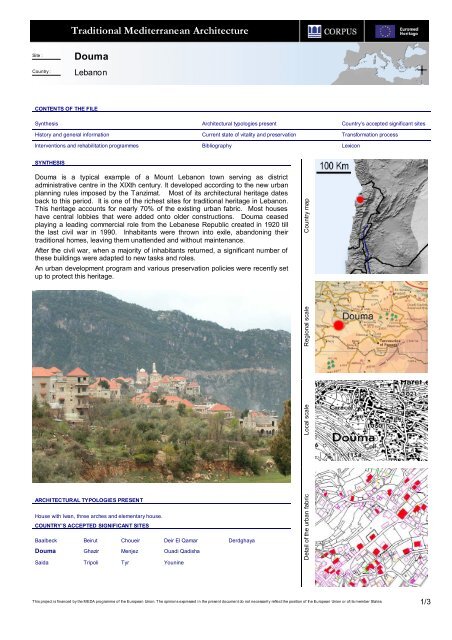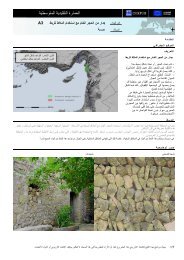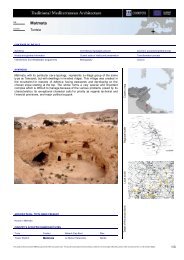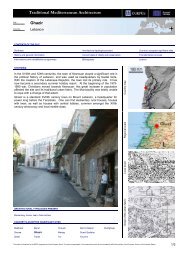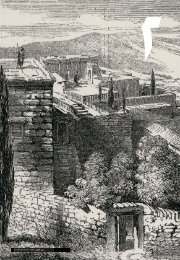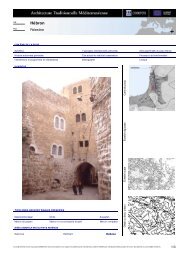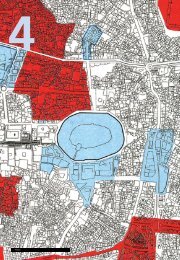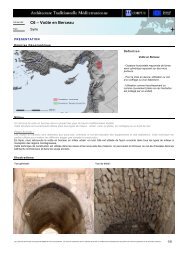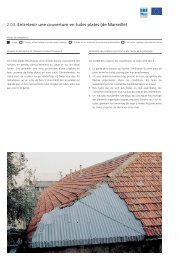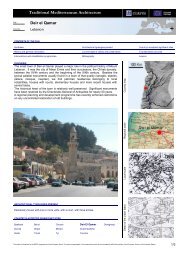Douma - CORPUS - Euromed Heritage
Douma - CORPUS - Euromed Heritage
Douma - CORPUS - Euromed Heritage
You also want an ePaper? Increase the reach of your titles
YUMPU automatically turns print PDFs into web optimized ePapers that Google loves.
Traditional Mediterranean ArchitectureSite :Country :<strong>Douma</strong>LebanonCONTENTS OF THE FILESynthesis Architectural typologies present Country’s accepted significant sitesHistory and general information Current state of vitality and preservation Transformation processInterventions and rehabilitation programmes Bibliography LexiconSYNTHESIS<strong>Douma</strong> is a typical example of a Mount Lebanon town serving as districtadministrative centre in the XIXth century. It developed according to the new urbanplanning rules imposed by the Tanzimat. Most of its architectural heritage datesback to this period. It is one of the richest sites for traditional heritage in Lebanon.This heritage accounts for nearly 70% of the existing urban fabric. Most houseshave central lobbies that were added onto older constructions. <strong>Douma</strong> ceasedplaying a leading commercial role from the Lebanese Republic created in 1920 tillthe last civil war in 1990. Inhabitants were thrown into exile, abandoning theirtraditional homes, leaving them unattended and without maintenance.After the civil war, when a majority of inhabitants returned, a significant number ofthese buildings were adapted to new tasks and roles.An urban development program and various preservation policies were recently setup to protect this heritage.Local scaleCountry mapRegional scaleARCHITECTURAL TYPOLOGIES PRESENTHouse with Iwan, three arches and elementary house.COUNTRY’S ACCEPTED SIGNIFICANT SITESBaalbeck Beirut Choueir Deir El Qamar Derdghaya<strong>Douma</strong> Ghazir Menjez Ouadi QadishaSaida Tripoli Tyr YounineDetail of the urban fabricThis project is financed by the MEDA programme of the European Union. The opinions expressed in the present document do not necessarily reflect the position of the European Union or of its member States. 1/3
Traditional Mediterranean ArchitectureHISTORY AND GENERAL INFORMATION<strong>Douma</strong>’s history allegedly goes as far back as the Phoenicians. It has only few Roman archaeological vestiges. The village wasfirst inhabited by orthodox Greeks who settled mainly in the north-western sector of the village. Catholic Greeks came fromBaalbeck in about 1759, and settled in the south-eastern area, after signing a treaty for the sharing of spring water with theorthodox population. The Maronites were the last minority to have settled in the town: they settled in the catholic district.Maronites who had family in Baalbeck were enticed to sell their goods in <strong>Douma</strong>. Likewise, Tripolitans came to <strong>Douma</strong> for trade,just as many other inhabitants from neighbouring towns. This made <strong>Douma</strong> a crossroad between the littoral towns of Baalbeck inBekaa. To face this amount of activity, souks holding over 100 shops were built in the heart of the village, after preparing on abasin-shaped piece of land for this purpose. In the XIXth century, the trade and craft industry played a significant role inincreasing the wealth of <strong>Douma</strong>’s inhabitants, making the town an administrative centre. In the 20 last years of the XIXth century,<strong>Douma</strong>’s citizens rivalled to erect the most beautiful homes, specifically houses with central lobbies with 3 arches on their mainfaçade. For the construction of their beautiful dwellings, they called upon master stone craftsmen from the villages of Choueir andKhenchara, in the Casa of Metn. These men of the art allegedly introduced an advanced technique of stone laying, a secret oftheir know-how: the heights reached practically doubled, the width of the walls was brought down from 80 cm to 35 cm. The nowwidened interior areas and openings were more beautiful than ever. The ironwork and woodwork were carried out by localcraftsmen.⎯ Surface area of the site 55 Ha⎯ Geographical co-ordinates 34º 12’ N ; 35º 50’ E⎯ Height above sea level 850 to 1.450 m⎯ Lithology Marly limestone, hard limestone,basalt, cimerite.⎯ Population 20 000 inhabitants, 16 000 of whichare immigrants⎯ Population density 75 inhab/Ha⎯ Average annual maximum temperatures 18,6ºC⎯ Average annual minimum temperatures 10,7ºC⎯ Average of maximum temperaturesduring the hottest month for ten years⎯ Average of maximum temperaturesduring the coldest month for ten years38,5ºC-10,6ºC⎯ Average rainfall 1435 mm⎯ Average number of days of rain per year 74 days⎯⎯Specific characteristicsRemarkable natural environment, sheer virgin mountain landscape, the towncarries on this traditional essence, a beautiful complex of dwellings with centralhalls, very lively souks in summer.Traditional economic activitiesWoodwork, ironwork, orchard and tree nurseries, commerce.General views of <strong>Douma</strong>⎯New economic activitiesSummer tourism (hotel + restaurants)⎯Site’s communications with its territoryRoadways. Mohafasat, north Lebanon, Batroun, 80km from BeirutThe soukThis project is financed by the MEDA programme of the European Union. The opinions expressed in the present document do not necessarily reflect the position of the European Union or of its member States. 2/3
Traditional Mediterranean ArchitectureCURRENT STATE OF VITALITY AND PRESERVATIONThe town of <strong>Douma</strong> is especially lively in summer. Most of its inhabitants work andreside in coastal cities, and spend their summers in the village.Patrimonial residences are generally well preserved and are regularly maintained.Few ruins.TRANSFORMATION PROCESSIn 1920s, after the creation of the Lebanese Republic, a new organization of theterritory is implemented. <strong>Douma</strong> ceased to play its role as commercial crossroad,and inhabitants migrated towards other towns on the coast. A lack of State interest(insufficient public equipment, lack of investment) contributed to the town’s decline.The 1975-1990 civil war worsened all the problems: <strong>Douma</strong> was on a secondarydefensive front. At the end of this war, in 1990, new constructions appeared withthe return of inhabitants. Huge concrete elements are added onto traditionalbuildings, destroying the harmony and specificity of the town. Hopefully, in mostcases, these transformations can be reversed or corrected.INTERVENTIONS AND REHABILITATION PROGRAMMESA new Town Council was elected in 1998 after a 35 years void: together with theAssociation for the Preservation of <strong>Douma</strong> <strong>Heritage</strong>, it is working on economicsolutions to maintain inhabitants in the village and encourage emigrants to comeback.An urban planning and development program has been developed and is currentlybeing implemented. The goal of this program is to draw up a detailed inventory ofall urban shapes, a global town profile plan, a plan for transportation and roadwaysystems, a plan for tourism and finally a plan for proper infrastructures: street lightsand garbage disposal.A study is currently carried out for the restoration of the souks, financed by theDirectorate-General for antiquities.Some buildings have already been restored, amongst which the town hall, followingthe instructions of the Association for the Preservation <strong>Douma</strong> <strong>Heritage</strong>. Aninventory of all traditional heritage is due in January 2004. The purpose of thisproject is to gather a large enough data base to decide on rehabilitation priorities.This project will be financed by the Association.ContactsAntoine Fischfisch, architect, urban planner, restorer.Téléphone : +961 3 601 460Streets in <strong>Douma</strong> and 3 arch close-up.BIBLIOGRAPHY- Fischfisch Antoine, Mise en valeur du patrimoine urbain et naturel de <strong>Douma</strong>, D.E.S.S d'Urbanisme, A.L.B.A, 1998.- Al Bacha Constantine, L’histoire de <strong>Douma</strong>, Imprimerie Pauliste (2ème édition), 1991.- Ghaoui Sawaya Gisèle, La personnalité géographique et le rayonnement régional de <strong>Douma</strong>, Mémoire en Géographie, Université Libanaise,1979.LEXICONTanzimat: Ottoman administration reform programCaza: Ottoman administration.Iwan: large arcadeFile created: 07.08.2003 Last modified: 10.12.2003This project is financed by the MEDA programme of the European Union. The opinions expressed in the present document do not necessarily reflect the position of the European Union or of its member States. 3/3


